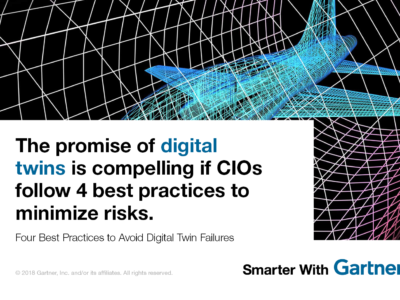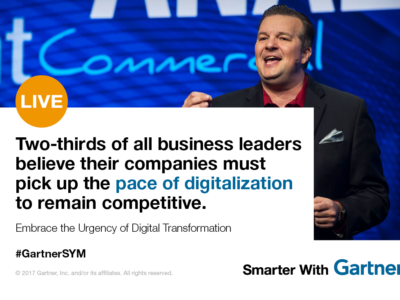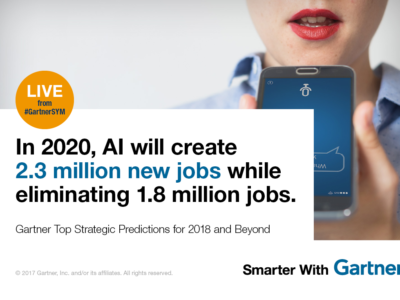3 Takeaways from the 2016 Gartner Hype Cycle for Digital Marketing and Advertising
Why the convergence of marketing and advertising presents new challenges for marketers.
Today’s customers expect unified and coordinated messaging across screens and channels, and that expectation drives unification of multichannel marketing and advertising activities. For example, one morning a customer receives an email from a large watch brand. Later that day, the customer searches online for watches. On his way home, he sees a mobile advertisement for a watch. Both of the later engagements were triggered by the email sent to him in the morning.
This convergence of marketing technology and advertising technology is one of the key trends in the 2016 Gartner Hype Cycle for Digital Marketing and Advertising.
Mike McGuire, research vice president, Gartner for Marketers, outlined this convergence and other key takeaways in the 2016 Hype Cycle for Digital Marketing and Advertising and noted that “improved customer experiences with contextually relevant messages built on complete profiles of customers and prospects point to a data-centric future for marketers.”
In the report, Mr. McGuire outlined five forces driving the evolution of emerging marketing and advertising technologies. Three of these forces in particular highlight the patterns of change and evolution in the marketing and advertising space.
Martech and adtech converge
In 2016 Gartner combined the digital marketing and advertising Hype Cycles into a single report to reflect the growing need for marketers to consider advertising technologies as an integral part of their main operational technologies. Marketers’ growing dependence on data-driven strategies and tactics continues to drive a convergence of martech and adtech. This convergence is reflected in the status of technologies such as digital marketing hubs.
Digital marketing hubs provide marketers with standardized access to audience data, content and messaging to orchestrate multichannel campaigns and experiences. Marketing organizations are clamoring for the converged out-of-the-box capabilities of this technology to reduce complexity and accelerate time to value.
Their benefit is expected to be transformational and is at the Peak of Inflated Expectations, despite being 5 to 10 years from mainstream adoption.
Read More: Rethink How You Evaluate Marketing Technology
Digital marketing hubs are transformational because of their ability to categorically improve marketing efficiency. They do this by giving marketers the ability to engage individuals, businesses and narrowly defined customer segments with tailored messages that are optimized for context. While the Trough of Disillusionment looms as some users discover hidden costs and limitations of these platforms, digital marketing hubs will ultimately raise baseline marketing efficiency to the point where few brands will remain competitive without it.
Other technologies shared across marketing and advertising technology stacks include data management platforms (DMPs), marketing analytics, marketing automation and predictive analytics. This is how marketers will deliver compelling and valued customer experiences, regardless of the market, product or service being promoted.
React in the moment
Predictive analytics, near the peak of the Hype Cycle, have the potential to help marketers make better decisions and anticipate outcomes. Examples include predicting demand, fraud detection, dynamic pricing, churn management and customer lifetime prediction.
Mobile marketing analytics have the ability to measure the behaviors of mobile website and application users.
Also near the peak, but farther on the horizon: Mobile marketing analytics have the ability to measure the behaviors of mobile website and application users. Analytics for mobile web and mobile apps provide quantitative data to optimize mobile site performance, improve app functionality and improve mobile advertising. Mobile marketing analytics are expected to deliver significantly increased revenue or cost savings for enterprises. “We expect mobile marketing analytics to move very quickly through the rest of its Hype Cycle journey,” Mr. McGuire said.
Increasing interest in wearables
Contextual cues driven by mobile devices such as local weather or presence near a retail store drive marketer interest in wearables and the Internet of Things (IoT). Wearables, which are moving down the peak, are objects such as clothing, smartwatches and wristbands designed to be worn on the body to connect information between physical and digital environments. Computing and electronic sensors enable these objects to record biometric and ambient information, transmit data to the cloud and connect to other “things.”
Read More: The New Disruptive Mobile Behavior
While the largest area of current investment in wearables belongs to the health and fitness market, the rise of the IoT and the accompanying flow of real-time data mean the big use case for wearables likely will be digital information for navigating the physical environment. Here, digital marketers will start incorporating wearables into multichannel marketing efforts to orchestrate brand interactions. Over the next two years wearables will help customers with real-time decision support as they traverse a buying journey.
“Don’t make decisions about where to invest based solely on a technology’s position on the Hype Cycle,” said Mr. McGuire. “Focus first on your business objectives. Evaluate all technologies that support your objectives, regardless of their impact and time to maturity, and remember to split your emerging technology investments among sure bets, potential game-changers and experiments.”
Get Smarter
Gartner for Marketers clients can read more in 2016 Hype Cycle for Digital Marketing and Advertising by Mike McGuire.
Get the full hype cycle and find the right tech solution to enhance your data-driven strategy.











